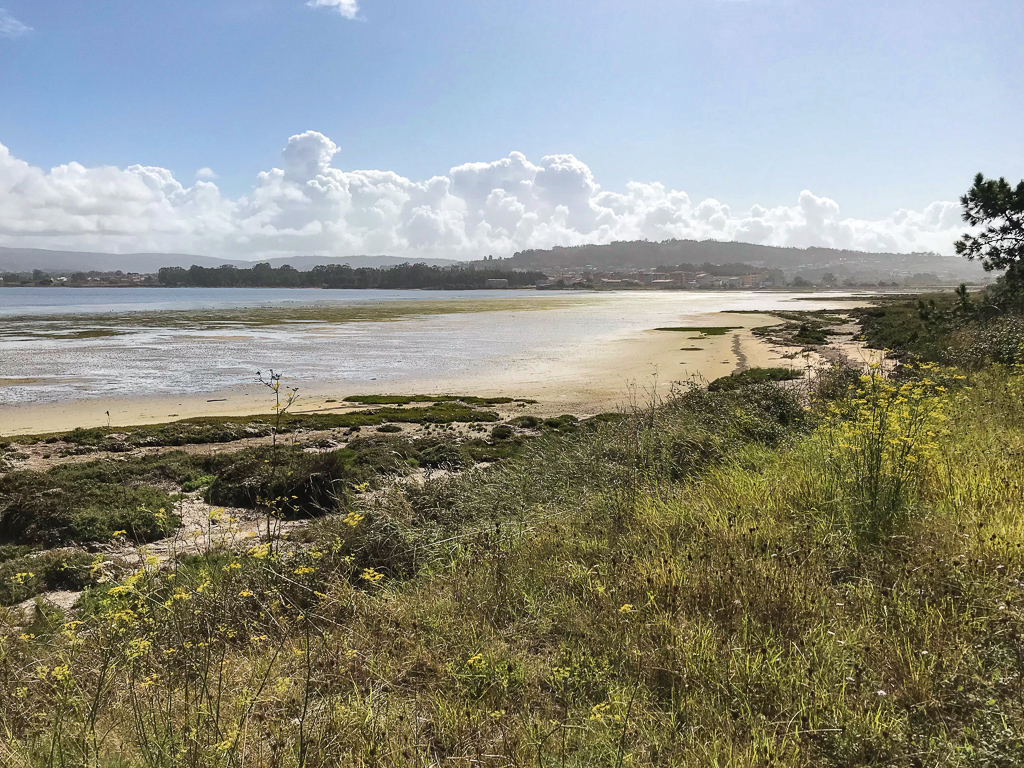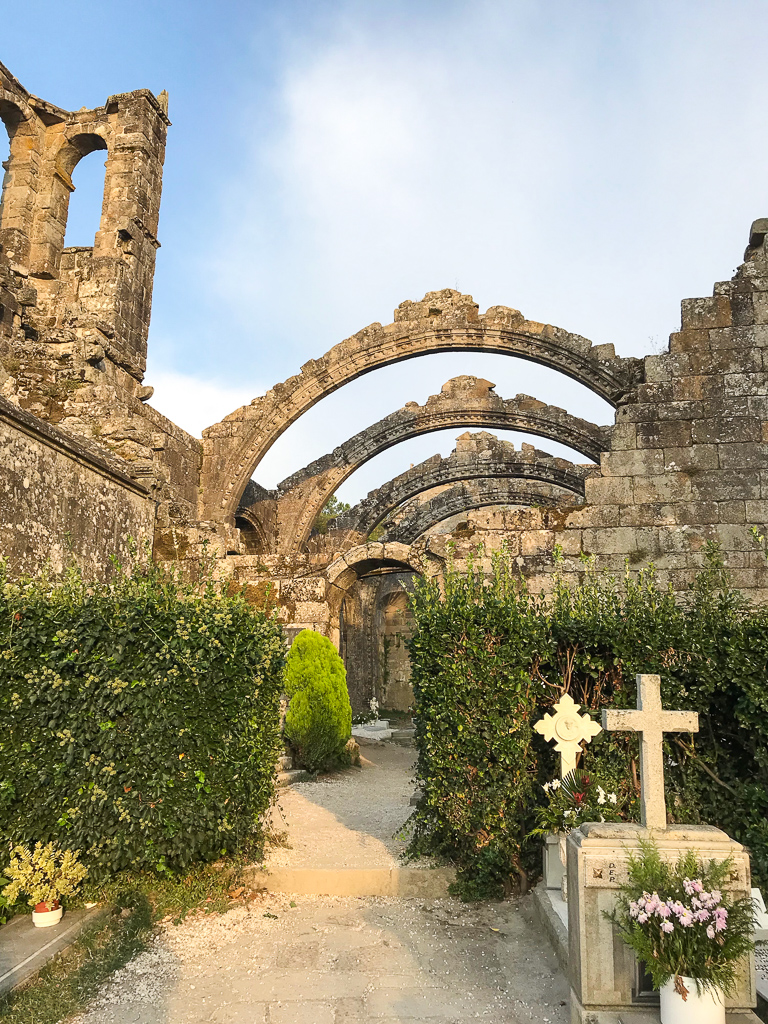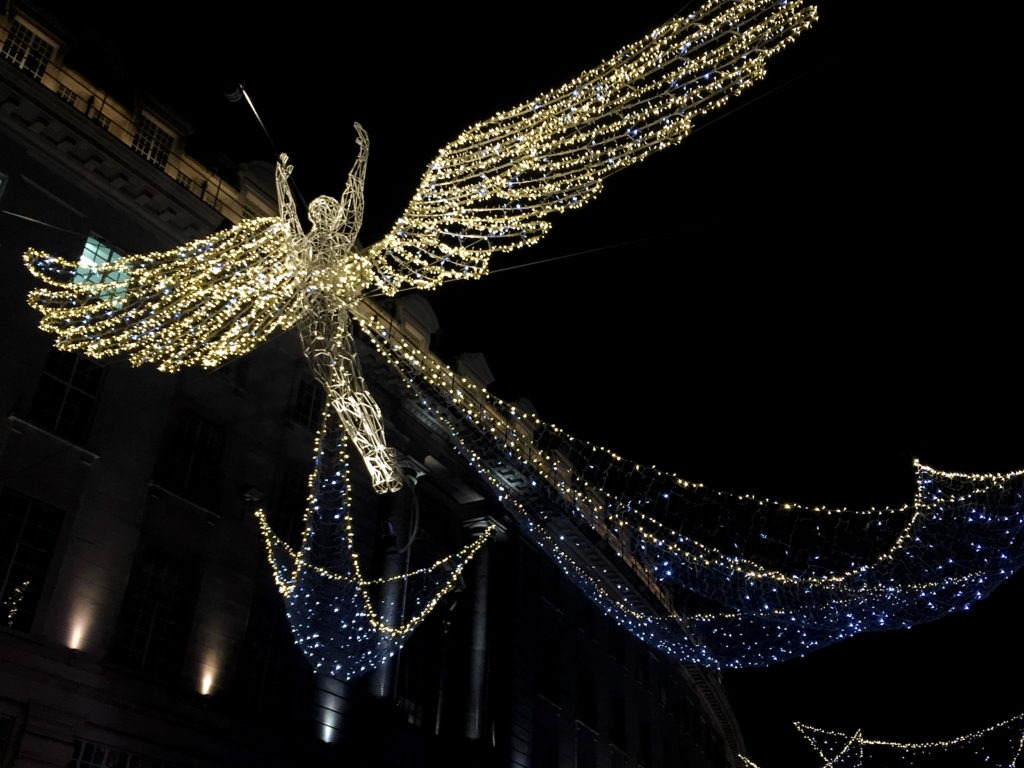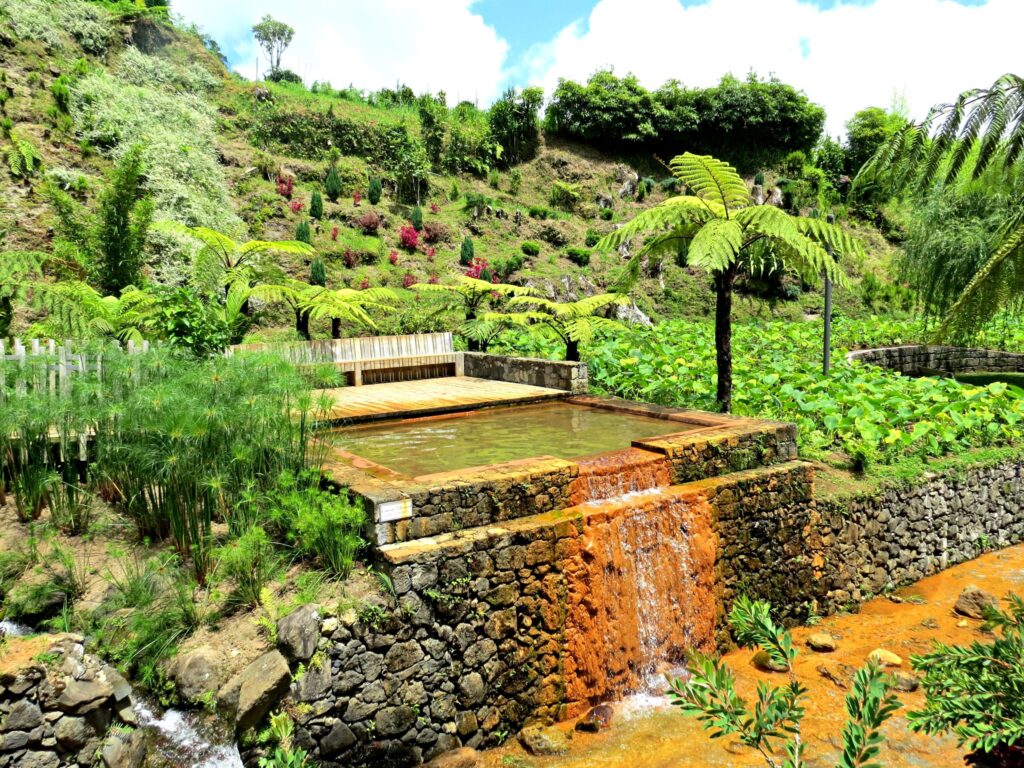This post is Part II of my short blog series on my trip to the Rías Baixas (“Lower Estuaries”), a coastal region in Galicia, Spain, in September 2019. Read Part I here. The Rías Baixas are made up of four rías: Ría de Muros e Noia, Ría de Arousa, Ría de Pontevedra, and Ría de Vigo. Each blog post will cover each ría in detail so that you can plan your own road trip around this beautiful, unique area of the world!
Galicia is a place of superstition. Much of the region’s folklore and legends involves elements of magic, mysticism and even witches. Why this is dates back thousands of years.
 We began our road trip of the day by heading northwest, further towards the ocean. On our way to the O Grove peninsula (more on that later) we stopped by an interesting site, the Ermida da Nosa Señora in A Lanzada. Ermida means hermitage, so this is a chapel where a group of people lived religiously, in seclusion. Built in the 12th century in the late Romanesque architectural style, it is of historical interest. The chapel is also set in a very idyllic place with a fantastic view of the sea.
We began our road trip of the day by heading northwest, further towards the ocean. On our way to the O Grove peninsula (more on that later) we stopped by an interesting site, the Ermida da Nosa Señora in A Lanzada. Ermida means hermitage, so this is a chapel where a group of people lived religiously, in seclusion. Built in the 12th century in the late Romanesque architectural style, it is of historical interest. The chapel is also set in a very idyllic place with a fantastic view of the sea.

 One of Galicia’s many legends revolves around the shores here. Local resident celebrate the festival of the Virgin at A Lanzada during the last weekend in August each year. On Saturday night, women who wish to end their infertility must go into the sea to be bathed by nine waves (nine representing the months of pregnancy and also being a sacred number to the Celtics). The ritual is reinforced by the couple entering the Cradle of the Saint, a set of natural stones in the shape of a cradle. This rite originates in pre-Christian beliefs including classical mythology as there are several allusions to the birth of Aphrodite, the goddess of love.
One of Galicia’s many legends revolves around the shores here. Local resident celebrate the festival of the Virgin at A Lanzada during the last weekend in August each year. On Saturday night, women who wish to end their infertility must go into the sea to be bathed by nine waves (nine representing the months of pregnancy and also being a sacred number to the Celtics). The ritual is reinforced by the couple entering the Cradle of the Saint, a set of natural stones in the shape of a cradle. This rite originates in pre-Christian beliefs including classical mythology as there are several allusions to the birth of Aphrodite, the goddess of love.


Ría de Arousa
We left this part of the Atlantic coast and traveled to Ría de Arousa. This ría is the largest and longest of Galicia’s estuaries. Within the ría there are several islands and islets. We chose to spend most of our time exploring the O Grove peninsula. The ría encloses the peninsula which faces the Atlantic Ocean. It’s a beautiful place, but is also well-known amongst domestic tourists! Access to the peninsula is via a strip of land that actually has a beach along one side, and a nature reserve on the other. The unique placement of the land in relation to the water makes this a great bird watching area!
 O Grove is actually the name of both the peninsula and the town. The town of O Grove has a large working port, stock full of shipping vessels. You can definitely tell the marine tradition is strong here.
O Grove is actually the name of both the peninsula and the town. The town of O Grove has a large working port, stock full of shipping vessels. You can definitely tell the marine tradition is strong here.

 From O Grove we ventured off to Illa da Toxa (illa meaning island). The island is accessed by a very narrow strip of land from the main part of the O Grove peninsula. This island is quite a strange place, as it’s the luxury destination of Galicia. Seriously, it has spas, hotels, a golf course, a casino, tennis courts, swimming pools and a mall.
From O Grove we ventured off to Illa da Toxa (illa meaning island). The island is accessed by a very narrow strip of land from the main part of the O Grove peninsula. This island is quite a strange place, as it’s the luxury destination of Galicia. Seriously, it has spas, hotels, a golf course, a casino, tennis courts, swimming pools and a mall.
We stayed away from all the fluff of the island, but we did run into a very interesting chapel called Ermida de San Caralampio e San Sebastián. If you look a little closer you’ll realise that the whole chapel is covered in scallop shells, from its base to the bell tower! Beautiful gardens surround the chapel, blending into the luxury of the island.


 From Illa da Toxa we ventured to the west side of the O Grove peninsula to O Carreiro. This is a spectacularly beautiful area, an area which really speaks for itself. I could’ve wandered around these rocks and shores for so much longer, but still so grateful I could even visit.
From Illa da Toxa we ventured to the west side of the O Grove peninsula to O Carreiro. This is a spectacularly beautiful area, an area which really speaks for itself. I could’ve wandered around these rocks and shores for so much longer, but still so grateful I could even visit.





Cambados
Following the ría north, we stopped at our last destination of the day. In my last post I introduced you to Albariño, the wine variety special to the Rías Baixas. Well, the epicenter of Albariño winemaking is in Cambados. While the town of Cambados has become quite touristy, we wanted to at least visit this famous town because of the wine.


 Once you walk through the town you’ll no doubt run into the main town square. It’s a large plaza, with the fortified Prazo de Fefinans and a large church surrounding it. The town square is representative of classic Galicia architecture.
Once you walk through the town you’ll no doubt run into the main town square. It’s a large plaza, with the fortified Prazo de Fefinans and a large church surrounding it. The town square is representative of classic Galicia architecture.

 The Prazo, now a bodega, offers limited tours. Though we were unable to go on any tours, we did see a magnificent sight. There are several wine merchants and bodegas specialising in the production of Albariño. While wandering around the plaza, we managed to see local farmers selling and delivering their Albariño grapes. It’s just a peak into a whole other world.
The Prazo, now a bodega, offers limited tours. Though we were unable to go on any tours, we did see a magnificent sight. There are several wine merchants and bodegas specialising in the production of Albariño. While wandering around the plaza, we managed to see local farmers selling and delivering their Albariño grapes. It’s just a peak into a whole other world.
If you want to actually taste some of those grapes in the form of wine, across the plaza you can try some Albariño paired with some Galician cheese. I can’t think of a better afternoon snack.


The Ruins
Our last stop was Ruinas de Santa Mariña de Dozo, the ruins of an old parish church. Santa Mariña is the patron of Cambados, and therefore this site holds special meaning for local residents. I also learned that this site is quite important in the world of cemeteries. There is an organisation called the Association of Significant Cemeteries of Europe, their goal being to promote European cemeteries as a fundamental part of the heritage of humanity. Interesting, no? In practical terms, the association is an European network of organisations, caring for cemeteries considered to be of historical or artistic importance. As you might imagine, Spain has several but sure enough the cemetery at Ruinas de Santa Mariña de Dozo is on the list. Once called the most melancholic cemetery in the world, it really is worth wandering around the intriguing and beautiful grounds.



We saw a tourist group approaching the cemetery, so we took that as our cue to head back to Raxó. And so ended our day trip to the O Grove peninsula and Ría de Arousa. It’s amazing how this ria contrasts so wonderfully and beautifully with the ría from the day before, Ría de Muros e Noia. It just shows that geographical proximity is not the only driver in developing culture. The day was such a mix of so many things, from the lives of fishermen to the lives of the rich and famous, from legends steeped in superstition to religious history. There is so much to delve into here.
Up next is a focus on the homebase, the ría we stayed along!




No Comments